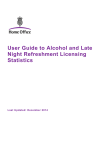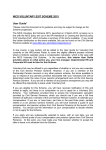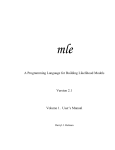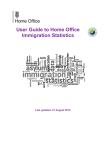Download Quality Report / User Guide – Northern Ireland Population Estimates
Transcript
Quality Report / User Guide – Northern Ireland Population Estimates NISRA Occasional Paper No. 32 September 2011 Jos IJpelaar, David Marshall, Sarah Paul and Kim Moylan Contents Executive Summary 3 1. Introduction 7 2. Production – Annual Data Sources 8 3. Quality Assurance – Annual Data Sources 9 4. Quality Assurance – Children (aged 0 to 15) 12 5. Quality Assurance – Older Persons (aged 65 and over) 14 6. Quality Assurance – Females aged 16 to 39 16 7. Quality Assurance – Males aged 16 to 39 18 8. Quality Assurance – Older working age (40 to 64) 20 9. Quality Assurance – Further Demographic Analysis 22 a. Sex-ratio b. Age-specific mortality rates c. Age-specific fertility rates 10. User Guidance 28 11. Future Developments 28 Annex A: Active Records on Health Card Register 30 Annex B: 2010 Mid-year population estimates and comparator 33 datasets by single year of age 2 Executive Summary 1. The Northern Ireland Statistics and Research Agency (NISRA) publishes official population estimates. Starting from the most recent Census results (2001), the population ages by one year every year, and adjustments are made to account for births, deaths and migration. The most recently released population estimates relate to mid-2010 and were published on 30 June 2011. 2. The production of the 2010 mid-year population estimates has been most challenging. Not only is 2010 the year most distant from the 2001 Census that still serves as the base population, but also the last decade has seen larger flows of in-migration to Northern Ireland than have been witnessed in the recent past. 3. The assessment of demographic statistics by the UK Statistics Authority highlighted “a lack of information about the quality and the reliability” of population statistics. It has triggered the production of this quality report. This report also provides a firm basis for the quality assurance of the population figures from the 2011 Census. 4. Multiple data sources are used in the process of producing and quality assuring the population estimates. These include births and deaths registrations from the General Register Office, the School Census, Child Benefit, Pension and related benefits, and the Health Card Register. For some of these sources, the quality has improved such that they could be considered being used for production rather than quality assurance of the population estimates. This is discussed further in the final section of the report. 5. One recent development is to look not only at registration, but at (the timing of) activity on registration systems. For example, the timing of activities such as the dispensing of prescriptions, treatment by a dentist or an optician, or changes in the registration details, can be linked to the Health Card Register to provide better evidence of residence compared to that of a historic registration. This work will be developed further as part of the quality assurance of the 2011 Census and the Beyond 2011 programme. 6. The comparison between the 2010 mid-year population and secondary data sources was carried out at the Northern Ireland level by single year of age. The findings are discussed by four distinct age groups: children (0-15 years), younger working age (16-39), older working age (40-64) and older persons (65+). Summary results are presented in Figure 1. 3 Figure 1: 2010 Mid-year population estimates and comparator datasets, by broad age group 8.0% 2010 population estimate: 382,000 Children (aged 0-15) 6.0% 4.0% 2.0% Comparator larger than population estimate 0.2% 0.0% -1.0% -2.0% -1.3% -1.3% -2.2% Comparator smaller than population estimate -2.8% Percentage difference from 2010 population estimate Percentage difference from 2010 population estimate 8.0% 7.6% 2010 population estimate: 595,000 persons of young working age (16-39) 6.0% 4.0% 2.1% 2.0% Comparator larger than population estimate 0.0% -2.0% -1.3% Comparator lower than population estimate -4.0% 2001 Census Rolled on Health Card register (June 2010) Active Records (June 2010) female correction Child Benefit (August 2010) School Census (October 2010) Births (July-June) -4.0% 2001 Census Rolled on 6.0% 6.0% 4.0% 2.0% Active Records (June 2010) - female correction 8.0% 2010 population estimate: 561,000 persons of older working age (40-64) Comparator larger than population estimate 1.5% 1.3% 0.0% Comparator lower than population estimate -2.0% Percentage difference from 2010 population estimate Percentage difference from 2010 population estimate 8.0% Health Card register (June 2010) 2010 population estimate: 260,000 persons aged 65 and over 6.0% 4.0% 2.0% Comparator larger than population estimate 0.3% 0.0% -0.1% -1.4% -2.0% Comparator lower than population estimate -4.0% 2001 Census Rolled on Health Card register (June 2010) Active Records (June 2010) - female correction -4.0% Health Card register (June 2010) Active Records (June 2010) - female correction Pension Benefits (July 2010) 7. The comparison for children (0-15 years) has the luxury of multiple comparator data sources, which show a very consistent picture of this population. The population estimates of single years of age are within 1% of these sources. The only exception is the population estimate for those aged 14, which is 3-4% higher than the other sources. This is likely to be, in part, a legacy of the estimated number of 5-year olds in the 2001 Census, which was already significantly higher than the 2001 School Census count. 8. The population estimates for those aged 65 and over can be compared to the Health Card Register and counts of pensions and related benefits. The estimates are within 1% of these sources, with the exception of one or two single years of age. 9. For the remaining ages, the only available comparator is the Health Card Register. The analysis for young working ages (16-39) is split between males and females. For females in their late twenties/early thirties, the number of active registrations in the Health Card Register is higher than the 2010 mid-year population estimates. This could be explained by lags in the Health Card Register, undercounts in the 2001 Census and/or underestimates of net in-migration since 2001. 10. Health service activity levels for males aged 16 to 39 are much lower than that of females of the same age. This makes the number of active registrations an overly conservative lower bound for the young working age male population estimate. When applying female age-specific activity rates to male health card registrations, thus raising the lower bound, population estimates are lower than corrected active health card registrations for males aged 27 to 39. 11. For both males and females of younger working age, the position of active health card registration exceeding the population estimate will be considered in detail as part of the analysis of the 2011 Census. 12. The quality of the estimates of the older working age population (40-64) improves compared to that of the younger working age, as there are lower levels of migration and increased uptake of health services, particularly by males. Having said that, the 2010 population estimates for ages 40 to 53 are below active health card registrations corrected for lower male activity levels. 13. Further demographic analysis was carried out to test internal robustness of the population estimates. The first of these tests is the sex ratio (males per female) by single years of age. This ratio starts of slightly above one, as there are more births of males than females, before falling marginally due to higher mortality rates of males, although this becomes more marked at age 60 and above. 14. It was found that sex ratios in the mid-year population drop below one male per female between ages 28 and 53. Most of this is a legacy from the 2001 Census population counts. In comparison, sex ratios based on the Health Card Register remain above one male per female until age 60. 15. Other demographic analyses demonstrated in this paper are mortality and fertility rates by single year of age. Both rates should have smooth patterns; mortality rates increase exponentially by age, and fertility rates follow a standard variation around a mean age. When using the 2010 population estimates, both mortality and fertility rates demonstrate this smoothness. Although this type of analysis can identify outliers at single years of age, it has to be considered alongside the comparisons with comparator data sources to assess over- and undercounts of population estimates. 16. The analyses described in this paper will be further developed and used in the quality assurance of the 2011 Census population figures. In particular, the work on active records on the Health Card Register is in its infancy. Another untapped source for estimating the population and/or quality assurance is the Department for Work and Pensions (DWP) database that records contributions from (self)-employment and benefits towards National Insurance. This will become part of the Beyond 2011 Population Statistics work programme, which will investigate better use of household surveys and administrative data. 6 1. Introduction 17. The Registrar General for Northern Ireland is responsible for producing estimates of the size of the population living in Northern Ireland under the 1969 Census Act. The main exercise to count the population is the decennial Census, which was most recently carried out on 27 March 2011. 18. The annual mid-year population estimate series provides figures for the size of the Northern Ireland population. This document describes the current data sources used in the production and quality assurance of the population estimate series. It looks specifically at four distinct age groups and compares the recently published 2010 mid-year population estimates with comparator datasets from administrative and statistical data sources. 19. The quality and availability of these comparator datasets has improved markedly over the last decade. However there are measurement issues with using these data to estimate the size of the population. This document outlines these measurement issues alongside new methods aimed at addressing these issues. This work will be developed further as part of the quality assurance of the 2011 Census and the Beyond 2011 programmes. However no changes to population estimate series will be made using this work until the first 2011 Census results are published next year. After the 2011 Census, NISRA will actively use these new methods alongside traditional methods to estimate the size of the population directly rather than just to assess the accuracy of the annual population estimates. 20. The assessment of demographic statistics by the UK Statistics Authority, published on 28 July 2011 1 , has highlighted a lack of information about the quality and the reliability of population statistics, particularly in relation to the potential uses and limitations. This report finishes with guidance for users of the annual Northern Ireland population estimate series. It also touches in conclusion on some likely future developments in the production of the annual population estimate series. 1 http://www.statisticsauthority.gov.uk/assessment/assessment/assessment-reports/assessment-report-124---statistics-ondemography-and-vital-events-in-northern-ireland.pdf 7 2. Production – Annual Data Sources 21. Mid-year population estimates are created using the cohort component methodology. This method starts with the population at the last reported Census (2001). It is important to note that the reported Census figures were derived from enumerated people plus an estimate of additional people to account for Census under-enumeration 2 . The 2001 mid-year population estimates were created from the 2001 Census with small adjustments made covering the time difference between Census Day (27th April) and the reference date for mid-year population estimates (30th June). For each year thereafter, the population is “aged on” by one year, and adjustments are made to account for births, deaths and migration since. More detail is described in the NISRA population estimates methodology report 3 . 22. The population estimates methodology report outlines the components of population change that are applied to the most recent published Census results. Each component has an associated data source. 23. Births and Deaths registrations are obtained from the General Register Office (GRO). Individual records are extracted based on the date of registration, not occurrence. Births to mothers who are resident outside Northern Ireland are excluded, as there are a significant number of mothers from outside Northern Ireland (most resident in the Republic of Ireland) who give birth in Northern Ireland every year. For deaths, it is assumed that the small number of non-resident deaths in Northern Ireland is compensated by deaths of Northern Ireland residents abroad 4 . 24. Migration estimates are based on registrations and de-registrations on the Northern Ireland and other UK Health Card Registers and the quarterly National Household Survey in the Republic of Ireland. Migration flows between the UK countries are based on receiving country health card registrations and are agreed between Northern Ireland and the other UK countries. Migration flows between Northern Ireland and the Republic of Ireland are based on health card registrations in Northern Ireland and the quarterly National Household Survey in the Republic of Ireland. Migration flows between Northern Ireland and countries outside the UK and Ireland are measured by new international health card registrations and de-registrations. This data is validated against flow data from other sources. Further detail on migration is available in the migration methodology paper 5 and in the annual migration report 6 . 2 2001 Census Methodology at: http://www.nisra.gov.uk/archive/census/methodologicalapproach2001.pdf 3 Population estimates methodology report is at http://www.nisra.gov.uk/archive/demography/population/midyear/mye_methodology.pdf 4 Information on the quality of vital statistics is available at: http://www.nisra.gov.uk/archive/demography/publications/vital_stats_QA.pdf 5 The migration methodology report is at http://www.nisra.gov.uk/archive/demography/population/migration/dev_est_mig.pdf 8 3. Quality Assurance – Annual Data Sources 25. For the quality assurance of mid-year estimates, other data sources are available. These sources are selected based on very high coverage of the population: School Census and Child Benefit data provide excellent coverage of the number of children, whilst the claimants of pension and other age related benefits are an excellent proxy for the population aged 65 and over. Finally, the Health Card Register provides comparators for all age groups. 26. The School Census is held each year in October for those attending primary, post-primary and special education. Figures from 2010/11 academic year – collected in October 2010 – can be compared to the 2010 mid-year population estimates. These figures will exclude children who a) are home educated – estimated to be around 1,000 children, particularly at younger ages; b) are attending boarding schools outside Northern Ireland but are resident in Northern Ireland; and c) are registered late with the school. 27. In addition, officials from the Department of Education estimated that the number of pupils from the Republic of Ireland who attend schools in Northern Ireland is balanced by Northern Ireland resident pupils who attend schools in the Republic of Ireland. Ages are calculated as of 30 June; school year information is used as a check on age7 . 28. Child Benefit data has high coverage of under-16s, as it is not a means-tested benefit. However there is only partial coverage of 16-18 year-olds, as receipt of this benefit is dependent upon attendance in full-time education (thus figures for those aged 16 and over are excluded from this paper). The child benefit register is maintained by Her Majesty’s Revenue and Customs. An abstract of the database is made on 31 August of each year; ages are then calculated as of 30 June of that year and children born after 30 June of that year are excluded from the statistics 8 . 6 The annual migration report is at http://www.nisra.gov.uk/archive/demography/population/migration/Migration%20Report%202009.pdf 7 Further information is at: http://www.deni.gov.uk/index/32-statisticsandresearch_pg/32statistics_and_research_statistics_on_education_pg/32_statistics_and_research-numbersofschoolsandpupils_pg/statistics_and_researchschool_census_documentation.htm 8 Further information is at: http://www.hmrc.gov.uk/stats/child_benefit/geographical.htm 9 29. At the UK level, there are 72,000 child benefit claims that cannot be allocated to a geographical area. In this analysis these claims have been redistributed by country and single year of age, resulting in an additional 0.5% or 2,000 claims aged 0 to 15 years for Northern Ireland. In addition evidence from the Family Resource Survey 9 suggests that Child Benefit is claimed on 98.8% of eligible children in Northern Ireland. Subsequently, an additional adjustment was made to the Child Benefit count to account for this. 30. There are several benefits that people aged 65 or more can claim, of which pension benefits and winter fuel payment are universal benefits payable to persons over a certain age: they are not income related, not taxable and not based on National Insurance Contributions. The Department for Social Development has supplied anonymised record level data of those and other benefits, including pension credit, disability living allowance, attendance allowance, and incapacity benefit. A dataset was created of all persons that claim one or more of these benefits. The download dates were mostly mid-July 2010, with the exception of the Winter Fuel Payments, for which claims at the end of February were included. It is therefore possible that, someone who only claimed Winter Fuel Payment could have died before the end of June. To account for this, persons who only claimed Winter Fuel Payment in 2010, but did claim other benefits in July 2009, were removed from this dataset as a proxy for deaths between the end of February and the end of June 10 . Evidence from the Family Resource Survey 11 suggests that 100% of pensioners surveyed receive non-income related benefits. The ages in pension and related benefit data were calculated as of 30 June. 31. Changes in the Health Card Register are used to create migration estimates. However the database also provides information on the number of current registrations and as such can be used as a comparator dataset. If someone moves to Great Britain and registers with a family doctor there, the registration in Northern Ireland is deactivated (a similar process works the other way). However, for migration to outside the UK, the onus of deregistering lies with the Health Card holder, with regular exercises held to verify the accuracy of the register for each family doctor. This issue is recognised in the estimates of international out-migration with suitable adjustments made to the numbers of health card register deregistrations. 9 See Table 2.15 of http://www.dsdni.gov.uk/index/stats_and_research/stats-publications/stats-familyresource/family_resources/statistics_and_research-frs0809.htm 10 This hypothesis was tested by looking at persons who only claimed Winter Fuel Payment in 2009, but did not claim other benefits in July 2008. None of these persons claimed any pension or related benefit in 2010 and thus can be presumed to have died. 11 See Table 2.12 of http://www.dsdni.gov.uk/index/stats_and_research/stats-publications/stats-familyresource/family_resources/statistics_and_research-frs0809.htm 10 32. Recently, work has been undertaken to look at whether there has been activity on live registrations of the Health Card Register. These activities include the dispensing of prescriptions, treatment by a dentist or an optician, or changes in the registration details, such as change of address or change of family doctor. Such activities can be seen as evidence of residence. Figures are available for total registrations and “active” registrations, by age and sex, for Northern Ireland of live records as on 1st April 2011. A registration was labelled “active” if there had been at least one activity in the past 24 months. From this dataset, age-sex specific activity rates were derived and applied to the July 2010 download of the Health Card Register as a proxy for active records at that mid-year point. The development of this work is still in its early stages, but there is clear merit in this approach. Further details from this work are included in Annex A. 33. In the next few sections, information from secondary data sources and the 2001 Census will be used to assess the quality of the 2010 mid-year population estimates. This will be done by looking at four distinct age groups: children (0-15 years), younger working age (16-39), older working age (40-64) and older persons (65+). Annex B reports the detailed figures used in the quality assurance graphs which follow. 11 4. Quality Assurance – Children (aged 0 to 15) 34. For children, the available secondary data sources are the birth register, the Health Card register, the Child Benefit system and the School Census. Figure 2 presents: a) the 2010 mid year estimates by single year of age; b) counts from the secondary data sources (Births, Health Card register, Child Benefit and School Census) by single year of age; c) active records from the Health Card register; and d) the 2001 Census figures rolled forward to 2010. 35. Due to lags in registration; counts from the health card system are only comparable to the mid-year population estimates from age one onwards. Similarly, Child Benefit is only comparable from the age of two onwards. Clearly School Census age-counts only apply from age four onwards (statutory school age); and the rolled forward Census counts from age nine onwards (i.e. 0 year olds in 2001 will be aged 9 in 2010). 36. Figure 2 shows a relatively narrow range of population counts: active and total health cards registrations are generally lower and upper bounds, with 900 records or less (3.5%) between these bounds for each single year of age. 37. Figure 2 shows that the difference between the School Census and Child Benefit is at most 400 children at any single year of age between 4 and 15 years: see Annex B for the detailed figures. Both School Census and Child Benefit figures exceed active health card counts at each age. This implies that there are a number of children who are resident in Northern Ireland but do not actively use primary health care services. 38. A point of interest in Figure 2 is the 2010 population estimate at age 14. This is an outlier, with the 2010 population estimate exceeding all other counts. The 2010 population estimate for 14 year olds relies on the 2001 Census count of 5-year olds. This is important as the 2001 Census count of 5-year olds was significantly higher than the 2001 School Census count of 5-year olds. Clearly the 2010 population estimate of 14 year olds will be scrutinised in detail as part of the 2011 Census. 39. Figure 2 also shows that the 2010 mid-year estimate is consistently higher than the rolled forward 2001 Census count. Given the low mortality of children this implies that over the last decade there has been significant in-migration of children to Northern Ireland. This estimate of in-migration of children has been ratified with other independent sources and is documented in the annual migration report 12 . 12 http://www.nisra.gov.uk/archive/demography/population/migration/Migration%20Report%202009.pdf 12 2010 Mid-year population and secondary data sources, children (non-zero y-axis) 26,000 25,000 24,000 Child Population Figure 2: 23,000 22,000 Mid-year estimate 2010 2001 Census Rolled on Child Benefit (August 2010) School Census (October 2010) Health Cards Register (June 2010) Active Health Cards (June 2010) Births (July-June) 21,000 20,000 0 1 2 3 4 5 6 7 8 Age at June 2010 13 9 10 11 12 13 14 15 5. Quality Assurance – Older Persons (aged 65 and over) 40. For the population aged 65 and over several sources are also available. These are a) the 2010 mid year estimates by single year of age; b) counts of pension and related benefits by single year of age; c) registrations on the Health Card Register by single year of age; d) active records from the Health Card Register and e) the 2001 Census figures rolled forward to 2010. Figures for ages 65 to 84 are shown graphically in Figure 3; details for all single years of age up to “85 and over” are given in Annex B. 41. As there is limited migration in this age group, the difference between the rolled forward 2001 Census and the 2010 population estimate is predominantly due to mortality. The difference between active and total health card counts drops from 500 persons at age 65 to less than 100 persons from ages 75 onwards, providing a probable narrow range for population estimates to fall in. 42. Figure 3 shows the number of pension related benefits claims lying between the active and total health cards counts up until the age of 70. Thereafter, the number of pension related benefits claims exceed the total number of health cards but by no more than 200 (1.5%). The 2010 mid-year population estimates follow closely the patterns of the Health Card register and claimants of pension related benefits, but marginally exceeding both at the older end of the 65-84 age-spectrum. For the population aged 85 and over (see Annex B), mid-year estimates are roughly 3% lower than the other data sources. 43. Figure 3 shows that the 2010 population estimate at age 67 is marginally below all three sources (between 0.5% and 3.3% lower). In addition Figure 3 also shows that the population estimates from age 78 onwards are marginally higher than all three sources, particularly at age 83 (between 4.4% and 6.9% higher). Again these specific estimates will merit further detailed scrutiny as part of the 2011 Census. 14 2010 Mid-year population and secondary data sources, persons aged 65-84 (non-zero y-axis) 20,000 17,000 Older Population Figure 3: 14,000 11,000 Mortality loss (2001-10) Mid-year estimate 2010 8,000 2001 Census Rolled on Health Cards Register (June 2010) Active Health Cards (June 2010) Pension Benefits (July 2010) 5,000 65 66 67 68 69 70 71 72 73 74 75 76 Age at June 2010 15 77 78 79 80 81 82 83 84 6. Quality Assurance – Females aged 16 to 39 44. For the population aged 16 to 64, there is only the full and active Health Card register as comparator datasets. This is a wide age group with significant levels of migration at the younger end of the age-spectrum. For the purpose of this discussion, this population is divided into the 16 to 39 age group (younger working age) and the 40 to 64 age group (older working age). 45. The analysis for the population aged 16 to 39 is split between males and females. In this age group mortality rates are low and the difference between the rolled-forward 2001 Census and the 2010 mid-year population estimate is driven by migration (see Figure 4). Where the rolled forward 2001 Census figures are higher than the 2010 population estimates, there has been net out-migration over the decade (those now aged 18 to 22). This is likely to be due to the impact of out-migration of young women from Northern Ireland to university in Great Britain. In contrast the opposite effect is observed for young women now in their late twenties and early/mid thirties. This is likely to be due to the population increases which have resulted from increased international migration during the last decade. 46. For females in their late twenties/early thirties, the number of active registrations in the Health Card Register is higher than the 2010 mid-year population estimates. This difference (for females aged between 27 and 39 inclusive) could be caused by a number of reasons either alone or in combination. They include: a) active health cards may include young women who, whilst having had a family health services activity in the previous 24 months, have now left Northern Ireland and have not yet had their health card registration transferred (within-UK migration) or cancelled (international migration); b) the estimates of in-migration since the 2001 Census for this age group are not large enough and/or estimates of out-migration could have been too large; and c) there may have been some under-enumeration of women (aged 18 to 30) in the 2001 Census even after the under-enumeration adjustment in the published Census figures. 47. In total an additional 4,500 females aged 27 to 39 would be required to be added to the 2010 population estimates to ensure that the estimates exceed the number of active health cards at every single year of age point. This issue will be considered in detail as part of the analysis of the 2011 Census. 16 Figure 4: 2010 Mid-year population and secondary data sources, females aged 16-39 (non-zero y-axis) 15,000 Young Adult Female Population Out-migration 12,000 In-migration 9,000 Mid-year estimate 2010 2001 Census Rolled on Health Cards Register (June 2010) Active Health Card (June 2010) 6,000 16 17 18 19 20 21 22 23 24 25 26 27 28 29 Age at June 2010 17 30 31 32 33 34 35 36 37 38 39 7. Quality Assurance – Males aged 16 to 39 48. When comparing the rolled forward 2001 Census and the 2010 mid-year population estimates a similar pattern of migration in the period 2001 to 2010 can be found for males (see Figure 5). Net out-migration is observed in males now aged 18 to 26 and net in-migration for males now aged 28 to 38. 49. However, the levels of health services activity drop faster for males than females. From ages 25 to 39, activity levels are around 82% for males and 94% for females (for details see Annex A). Survey results 13 confirm the lower utility rates of health services by males. 50. Registrations on the Health Card Register can be considered an upper bound, and active records a lower band for population estimates. The widely acknowledged lower use of health services by young men makes the number of active registrations an overly conservative lower bound for the population estimate. One option is to apply the female age-specific health card activity rates to the number of male registrations, making the range much smaller. This provides an alternative, and perhaps more useful, lower bound (denoted as the “female correction” in Figure 5). 51. The 2010 mid-year population estimates appear to follow the corrected active registrations series up until age 27; thereafter, the 2010 mid-year estimates lies between the original and corrected active registrations. This would suggest there may be too few adult males aged 27 to 39 in the 2010 mid-year estimates. However the caveats given in paragraph 46 also apply - these issues will need to be considered in the production of the 2011 population estimates following the Census. 13 See http://www.csu.nisra.gov.uk/CHS%20Bulletin%20200809.pdf and http://www.statistics.gov.uk/downloads/theme_compendia/GLF09/GeneralLifestyleSurvey2009.pdf and DHSSPSNI (2009), Public Attitudes to Health and Social Care Services in Northern Ireland 2009 18 2010 Mid-year population and secondary data sources, males aged 16-39 (non-zero y-axis) 15,000 Out-migration Young Adult Male Population Figure 5: 12,000 In-migration 9,000 Mid-year estimate 2010 2001 Census Rolled on Health Cards Register (June 2010) Active Health Card (June 2010) - Female Correction Active Health Card (June 2010) 6,000 16 17 18 19 20 21 22 23 24 25 26 27 28 29 Age at June 2010 19 30 31 32 33 34 35 36 37 38 39 8. Quality Assurance – Older working age (40 to 64) 52. There are low levels of migration in the population aged 40 to 64. Between mid-2009 and mid-2010, less than 500 people or 0.1% of the population in this age group moved to Northern Ireland. Figure 6 shows little difference between the 2010 mid-year population estimates and the figures rolled forward from the 2001 Census. 53. Figure 6 also shows that the 2010 mid-year population estimate lies between the number of active records and the total number of health card registrations. 54. Also denoted in Figure 6 is the female corrected series of the active Health Card register, i.e. the age-specific activity level of females applied to male registrations on the Health Card Register. It can be seen that the importance of this adjustment wanes in late middle-age as late middle-aged males and females have similar activity rates (by age 60, males have 93% activity and females 97% activity). In addition, as the population gets older, mortality has an impact and explains the discernable gap between the rolled forward 2001 Census and the mid-year population estimates from age 55 onwards. 20 2010 Mid-year population and secondary data sources, persons aged 40-64 (non-zero y-axis) 30,000 27,000 Older Working Age Population Figure 6: 24,000 21,000 Mid-year estimate 2010 2001 Census Rolled on Health Cards Register (June 2010) 18,000 Active Health Cards (June 2010) - Female Correction Active Health Cards (June 2010) 15,000 40 41 42 43 44 45 46 47 48 49 50 51 52 53 Age at June 2010 21 54 55 56 57 58 59 60 61 62 63 64 9. Quality Assurance – Further Demographic Analysis a. Sex-ratio 55. Population estimates have to be internally robust, i.e. they should be plausible in reflecting the life cycle of people and historic population figures. One of these internal checks is the sex-ratio, commonly expressed as the number of males per female. Biologically there are around 5% more births of males than females, providing a sex ratio of around 1.05 males per female at age 0 14 . 56. As the population ages, the ratio will initially fall marginally due to higher mortality of males, although the differential becomes more marked at older ages (above 60) as male mortality rates exceeds those for females. Deviation from this simple hypothetical sex ratio curve requires questioning 15 . 57. Figure 7 shows the age-specific sex ratios from the 2010 mid-year population estimates alongside those from the 2001 Census. It shows a decline in the 2001 Census sex-ratio curve that was faster and earlier than would be expected, before recovering to expected values in the late forties. 58. In terms of the 2010 mid-year estimates the peaks and troughs from the 2001 Census have been rolled forward, for example, the recovery in sex ratio at age 46/47 in 2001 can still be observed at ages 55/56 in 2010. The impact of the improved mortality of older males shows that the fall in the sex-ratio has shifted over the decade. 59. Other data sources such as the Health Card Register can provide sex-ratios. For 2010, it was found that these ratios do not drop below one male for every female until age 60, when the mortality differential kicks in. Clearly sex-ratios will be explored further in the 2011 Census. 14 See Table 1.1 of the Registrar General Annual Report: http://www.nisra.gov.uk/archive/demography/publications/annual_reports/2009/Table1.1_2009.xls 15 Detailed analysis on sex ratios in England and Wales was carried out by the Office for National Statistics: http://212.58.231.24/articles/population_trends/SmallwoodPT137web.pdf 22 Figure 7: Sex ratios in 2001 Census and 2010 mid-year population estimates (non-zero y-axis) 1.10 Effect of rolling on 2001 Census 1.00 0.80 0.70 Mid-year estimate 2010 0.60 2001 Census Age 23 84 81 78 75 72 69 66 63 60 57 54 51 48 45 42 39 36 33 30 27 24 21 18 15 12 9 6 3 0.50 0 Males per female 0.90 b. Age-specific mortality rates 60. A second tool for internal validation of population estimates is to look at age-specific mortality rates. The Gompertz–Makeham law 16 states that the death rate is the sum of an age-independent component and an age-dependent component, which increases exponentially with age. In a protected environment where external causes of death are rare, the age-independent mortality component is often negligible. Figure 8 shows the age-specific mortality rates for males and females for ages 16 to 84 on a logarithmic scale. These rates are based on provisional figures of deaths registered between July 2010 and June 2011, and the 2010 mid-year population estimates. Note there have been no deaths of females aged 26 in this time period, hence the gap in the mortality rate series. Figure 8: 2010/11 deaths per 2010 mid-year population, by sex (log scale y-axis) 2010/11 deaths per 100,000 mid-2010 population - log scale 10,000 2010/11 deaths per 100,000 mid-2010 population - Males 2010/11 deaths per 100,000 mid-2010 population - Females 1,000 100 10 82 79 76 73 70 67 64 61 58 55 52 49 46 43 40 37 34 31 28 25 22 19 16 1 Age at 30 June 2010 61. The exponential age-dependent mortality component is apparent from age 40 onwards. It must be noted that there are very low number of deaths by single year of age up to the age of 40, particularly for females, hence the volatility of age-specific mortality rates. 16 http://en.wikipedia.org/wiki/Gompertz%E2%80%93Makeham_law_of_mortality 24 62. External causes of death, linked to the age-independent component, are particularly prominent in deaths of males aged 16 to 39; this age group accounts for 40% of all external male deaths, and two-thirds of deaths of 16 to 39 year olds were due to external causes. For females though, external causes of death are less prominent: one-third of deaths of 16 to 39 year old females were due to external causes. Information on the cause of death for those registered in 2010-11 is not yet available. Figure 9 shows age-specific mortality rates for 2009-10, where deaths due to external causes have been excluded. These rates have been derived using the 2009 mid-year population estimates and deaths registered between July 2009 and June 2010. Note there have been no deaths of females aged 16 and 21 to 23 in this time period, hence the gap in the mortality rate series. Considering the small number of deaths at the younger spectrum – and subsequent greater volatility, the pattern of mortality rates appear to be linear for the entire 16 to 84 age group. Figure 9: 2009/10 deaths (excl. external causes) per 2009 mid-year population, by sex (logarithmic scale y-axis) 1,000 100 10 2009/10 deaths (excl. external causes) per 100,000 mid-2009 population - Males 2009/10 deaths (excl. external causes) per 100,000 mid-2009 population - Females Age at 30 June 2009 25 82 79 76 73 70 67 64 61 58 55 52 49 46 43 40 37 34 31 28 25 22 19 1 16 2009/10 Deaths (excl.external causes) per 100,000 mid-2009 population - log scale 10,000 c. Age-specific fertility rates 63. Finally, information on the number of births can be used to quality assure population estimates of females of childbearing ages (15 to 44). Figure 10 shows the number of live births per 1,000 women by mother’s age at birth (age-specific fertility rates), based on the number of births registered in the 2001 and 2010 calendar years. The total numbers of births for these years were 22,000 and 25,300 respectively. The general pattern of the 2010 fertility rates appear to be smoother than that in 2001. The peak in fertility rates has moved up by one year, and the bulge of rates in the late teens and early twenties has become less prominent. This bulge can be explained by the existence of two sub-populations of a different size, mean age at birth and variation around this mean age 17 . This pattern in age-specific fertility rates has also been observed in the UK and other European countries. Figure 10: Live births per 1,000 women, by age, 2001 and 2010 150 Live births per 1,000 women - 2001 Live births per 1,000 women - 2010 Births per 1,000 women 120 90 60 30 0 15 16 17 18 19 20 21 22 23 24 25 26 27 28 29 30 31 32 33 34 35 36 37 38 39 40 41 42 43 44 Age of mother at birth 17 Peristera, P. and Kostaki, A. (2007). Modeling fertility in modern populations. Demographic Research 16(6): 141-194. http://www.demographic-research.org/Volumes/Vol16/6/16-6.pdf 26 64. The age-specific fertility rates can also be calculated based on the active health card register (see Figure 11). As expected from the findings in Figure 4, age-specific fertility rates are similar or near identical with the exception of ages 28 to 32. In this age group, the number of active records on the health card register exceeds the population estimates, hence fertility rates are lower. The overall effect on the Total Period Fertility Rate 18 is a fall from 2.06 to 2.03. Figure 11: 2010 Age-specific fertility rate, based on population estimates and health card register active records 150 Live births per 1,000 female Health Card Register Active Records Live births per 1,000 female mid-2010 population Births per 1,000 women 120 90 60 30 0 15 16 17 18 19 20 21 22 23 24 25 26 27 28 29 30 31 32 33 34 35 36 37 38 39 40 41 42 43 44 Age of mother at birth 18 Total Period Fertility Rate is defined as the theoretical average number of children who would be born alive to a woman during her lifetime if she were to pass through her childbearing years conforming to the age-specific fertility rates of a given year. 27 10. User Guidance 65. Population estimates can be used for a large number of purposes. These include: a) absolute numbers for the allocation of funds and the planning of services; b) to create indicators, for example, employment and unemployment rates; c) as a research tool to describe the demography of the population; d) to gross-up social or economic survey results. 66. The published tables of population estimates report figures to the nearest person, although footnotes to these tables state that “precision of the population estimates could be considered to be no better than to the nearest 100”. 67. It is important that users assess the impact of minor changes to the baseline population figures in their analysis. This report indicates the level of precision of mid-year estimates and it is important that any analysis does not overly rely on the implied accuracy of the figures as presented. Population estimates for children, older persons and the middle aged are within 1% of comparator data sources. Clearly population estimates for younger adults are less accurate than this; its population estimates are within 2-3% of comparator data sources. 11. Future Developments 68. The production of the 2010 mid-year population estimates has been most challenging. Not only is 2010 the year most distant from the 2001 Census that still serves as the base population, but also the last decade has seen larger flows of in-migration to Northern Ireland than have been witnessed in the recent past. 69. The results from the 2011 Census will help to provide an improved picture of the size and age-structure of the Northern Ireland population. After the 2001 Census results were released, a review was carried out of the population estimates between 1992 and 2000, which used the 1991 Census as the base population. One of the findings was the level of unrecorded out-migration, which led to a revision of the migration estimation methodology. Population figures for 1992 to 2000 were revised accordingly. It is envisaged that a similar exercise will be carried out after the 2011 Census results are available, with the possibility of revising 2002-2010 or earlier population estimates and/or the methodology for estimating migration. 28 70. The Beyond 2011 Population Statistics Programme 19 was set up by the UK Statistics Authority to establish and test models that will, in future, meet users’ needs for census type statistics in the UK, including wider socio-demographic statistics. It is internationally recognised that it is becoming increasingly challenging to conduct traditional censuses, partly because of the complexity of doing so with increasingly mobile populations. The Beyond 2011 work programme will investigate better use of administrative data and household surveys, assessing whether their purpose can be shifted from quality assurance to estimating the annual population estimates directly. 71. This report sets out the first tentative steps being taken in Northern Ireland; in particular the analysis of active records in the Health Card Register is in its infancy. There is a wealth of information available on the access to, and timing of, health services. In particular “activity within the previous 24 months” may not be appropriate for all ages. Similarly, there may be better combinations of the access to, and timing of, health services to reflect the size of the population. 72. One of the most underused data sources is the Department for Work and Pensions (DWP) database that records contributions from (self)-employment and benefits towards National Insurance. Access to and use of this data would be particularly welcome as the Health Card Register is currently the only data source covering persons of working age. It is believed that activity levels on the DWP database may be higher and timelier for young males than that of the Health Card Register. The Office for National Statistics is investigating how this data can be used to improve population estimates 20 . 73. Later this year, NISRA will update the report on long-term international migration 21 . It provides evidence from administrative and statistical sources in support of the official migration estimates. These data sources are provided by the United Kingdom Border Agency, Home Office, Department for Work & Pensions, Department of Education, Higher Education Statistics Agency, General Register Office, Northern Ireland Housing Executive, Labour Force Survey, and Continuous Household Survey. NISRA September 2011 19 http://www.ons.gov.uk/about/what-we-do/programmes-projects/beyond-2011 20 http://www.ons.gov.uk/about-statistics/methodology-and-quality/imps/mig-stats-improve-prog/programme-minutes-and-papers/workinggroup-papers/summary-of-the-access-28-july-2010.pdf 21 http://www.nisra.gov.uk/archive/demography/population/migration/Migration%20Report%202009.pdf 29 Annex A: Active Records on Health Card Register A.1 There are several databases held by HSC Business Services Organisation (BSO) that contain information on the provision of primary health care services in Northern Ireland, which can be linked to the Health Card Registration system. These databases are the medical registration system, the pharmacy database, the ophthalmic database and the dental database. A.2 The Medical database includes registration, medical card request, and amendments of GP, address, name and/or other information contained on the Health Card Registration. Activity is based on the date of recording. A.3 The Pharmacy database (EPES) contains information on dispensed prescriptions. It includes successfully scanned prescriptions after they have been processed by pharmacists. Activity is based on the date that the prescription was dispensed. A.4 The Ophthalmic database covers three areas: the provision of NHS sight test, the provision of a voucher for NHS glasses or the repair to a pair of glasses. Activity is based on the month in which claims were submitted to the HSC Business Services Organisation by the optician. This type of treatment tends to be a one-off occurrence with no ongoing claims submitted. A.5 The Dental database includes all NHS dental treatment; dental treatment undertaken privately for patients is not recorded by the BSO. Dental activity data is based on the completion date of the treatment. While some dental treatments can be ongoing, most dentists would submit claims periodically rather than wait until the end of treatment, particularly with orthodontic treatment. A.6 Figure A.1 shows a thematic representation of the number and type of activity on the Health Card register that has been recorded in the 24 months prior to April 2011. Although not presented as such, any combination of activity on the four databases is perceivable (for example, both Medical and Ophthalmic). The most common activity relates to the dispensing of prescriptions (pharmacy), which is used by 83% of all health card registrations, followed by dental (57%), medical (26%) and ophthalmic (23%). 30 Figure A.1: Thematic representation of active records in Health Card Register All Medical Pharmacy Dental Ophthalmic Had an interaction 499,000 This column represents the full health card population FPS 1,574,600 1,071,800 = 437,300 1,891,000 1 April 2011 1,762,800 No recorded interaction 128,100 A.7 The overall activity level of family health services is 93%, however, this varies by age and gender (see Figure A.2). At ages 0 and 1, this percentage is 100%, as the first registration of babies is treated as an activity. For children, the percentage drops to around 96%, then picking-up slightly for teenage girls. A.8 In the early twenties, utility levels drop to reach 94% for adult females and 84% for adult males in their late twenties. From then on, activity levels recover between the ages 30 and 50; activity levels for males rise from 81% at age 30 to 88% at age 50. By the age of 70, activity is up to 97%, less than 2% below levels for females. At the oldest ages, there is very little difference in activity levels between the two genders. 31 Figure A.2: 24 month activity levels for Health Card registrations, by age and sex, April 2011 (non-zero y-axis) 95% 90% 85% Males 80% Females Age 32 84 81 78 75 72 69 66 63 60 57 54 51 48 45 42 39 36 33 30 27 24 21 18 15 12 9 6 3 75% 0 Active registrations as percentage of total Health Cards 100% Annex B: 2010 Mid-year population estimates and comparator datasets by single year of age (thousands) Age Mid-year estimate 2010 0 25.2 22.6 22.1 22.1 24.5 25.0 1 25.7 25.3 25.3 25.3 25.0 25.4 2 25.7 25.5 25.1 25.1 25.1 25.2 3 24.3 24.3 23.7 23.7 24.0 4 23.4 23.4 22.7 22.7 23.1 23.2 5 23.1 23.1 22.5 22.5 22.9 23.0 6 22.8 22.8 22.3 22.3 22.6 22.6 7 22.2 22.3 21.7 21.7 22.1 21.9 8 22.2 22.4 21.7 21.8 22.2 21.9 9 22.3 21.5 22.4 21.7 21.7 22.2 21.9 10 23.0 22.3 23.1 22.3 22.4 22.8 22.6 11 24.0 23.1 24.2 23.4 23.4 23.9 23.7 12 24.3 23.6 24.5 23.7 23.8 24.3 24.0 13 25.0 24.3 25.3 24.5 24.6 25.0 24.8 14 24.7 24.0 24.3 23.5 23.7 24.0 23.8 15 24.2 24.1 24.7 24.0 24.2 24.6 24.2 2001 Census Rolled on Health Card register (June 2010) Active Records (June 2010) Active Records (June 2010) female correction Child Benefit (August 2010 ) 33 School Census (October 2010) Births (July-June) Pension Benefits (July 2010) Age Mid-year estimate 2010 2001 Census Rolled on Health Card register (June 2010) Active Records (June 2010) Active Records (June 2010) female correction 16 24.7 24.3 25.1 24.4 24.6 17 25.0 24.8 25.5 24.7 25.0 18 24.8 25.7 26.6 25.7 26.1 19 24.3 26.1 25.4 24.3 24.8 20 24.5 26.0 25.3 23.7 24.6 21 25.1 26.3 25.7 23.5 24.7 22 26.3 26.9 26.8 24.2 25.5 23 26.8 27.1 27.4 24.7 26.2 24 26.9 27.1 27.7 24.6 26.1 25 26.9 27.2 27.8 24.5 26.2 26 26.3 26.4 27.6 24.4 26.1 27 25.8 25.5 27.9 24.4 26.1 28 24.6 23.7 27.5 24.1 25.8 29 24.4 22.9 27.9 24.4 26.2 30 25.1 22.7 28.5 24.9 26.7 31 23.9 22.0 27.2 23.8 25.6 32 22.8 21.4 25.6 22.3 24.0 33 22.4 21.4 25.0 21.9 23.4 34 23.0 21.7 25.7 22.5 24.1 35 22.9 21.7 25.5 22.4 23.9 36 23.7 22.9 26.4 23.0 24.6 37 24.7 24.0 27.3 24.0 25.6 38 24.8 24.5 27.2 24.1 25.6 39 25.6 25.3 28.2 25.0 26.5 34 Child Benefit (August 2010 ) School Census (October 2010) Births (July-June) Pension Benefits (July 2010) Age Mid-year estimate 2010 2001 Census Rolled on Health Card register (June 2010) Active Records (June 2010) Active Records (June 2010) female correction 40 25.4 25.2 27.8 24.8 26.2 41 25.7 25.6 28.3 25.3 26.7 42 26.1 25.9 28.5 25.5 26.8 43 26.1 26.1 28.4 25.5 26.8 44 26.0 26.2 28.3 25.5 26.8 45 26.5 26.8 28.6 25.9 27.1 46 26.3 26.4 28.3 25.6 26.8 47 25.4 25.8 27.4 24.8 25.9 48 25.0 25.1 26.7 24.4 25.4 49 24.8 24.8 26.5 24.4 25.2 50 23.8 24.2 25.3 23.3 24.2 51 23.1 23.2 24.7 22.7 23.6 52 22.9 23.2 24.4 22.5 23.3 53 22.0 22.3 23.1 21.5 22.2 54 21.5 21.8 22.4 20.8 21.6 55 20.2 20.8 20.9 19.5 20.1 56 19.9 20.5 20.7 19.3 19.8 57 19.7 20.3 20.5 19.2 19.7 58 18.9 19.5 19.3 18.2 18.6 59 19.0 19.4 19.5 18.4 18.8 60 19.0 19.6 19.5 18.6 18.9 61 18.8 19.5 19.3 18.5 18.8 62 18.9 19.6 19.1 18.4 18.7 63 19.1 20.0 19.6 19.0 19.3 64 17.4 18.4 17.8 17.2 17.4 35 Child Benefit (August 2010 ) School Census (October 2010) Births (July-June) Pension Benefits (July 2010) Age Mid-year estimate 2010 2001 Census Rolled on Health Card register (June 2010) Active Records (June 2010) Active Records (June 2010) female correction 65 17.2 18.2 17.2 16.7 16.8 17.0 66 17.2 18.4 17.4 16.9 17.1 17.1 67 16.6 18.1 17.2 16.7 16.8 17.1 68 14.9 16.3 15.1 14.7 14.8 15.0 69 13.5 15.0 13.5 13.3 13.3 13.5 70 13.3 14.8 13.4 13.1 13.2 13.3 71 13.3 14.9 13.1 12.9 12.9 13.2 72 12.7 14.5 12.9 12.7 12.7 12.9 73 12.6 14.5 12.5 12.3 12.3 12.6 74 11.7 14.0 11.8 11.6 11.6 11.8 75 11.0 13.3 10.9 10.8 10.8 11.0 76 10.6 12.9 10.4 10.2 10.3 10.4 77 10.1 12.8 10.0 9.9 10.0 10.1 78 9.7 12.5 9.5 9.4 9.4 9.6 79 9.3 12.4 9.0 8.9 8.9 9.2 80 8.6 12.0 8.4 8.3 8.4 8.5 81 8.0 11.5 7.7 7.6 7.6 7.8 82 7.2 11.0 7.1 7.0 7.0 7.2 83 7.1 11.0 6.6 6.6 6.6 6.8 84 6.2 10.5 5.9 5.9 5.9 6.0 85+ 29.7 90.1 30.7 30.4 30.4 31.1 36 Child Benefit (August 2010 ) School Census (October 2010) Births (July-June) Pension Benefits (July 2010) Contact information For further information on the content of this report contact: Northern Ireland Statistics and Research Agency Customer Services McAuley House 2-14 Castle Street BELFAST BT1 1SA Telephone 028 9034 8160 Fax 028 9034 8161 E-mail [email protected] Website www.nisra.gov.uk Responsible Statistician Dr David Marshall © Crown Copyright 2011 37

















































